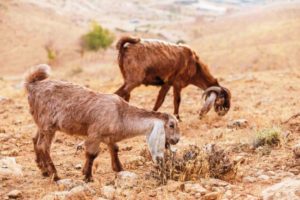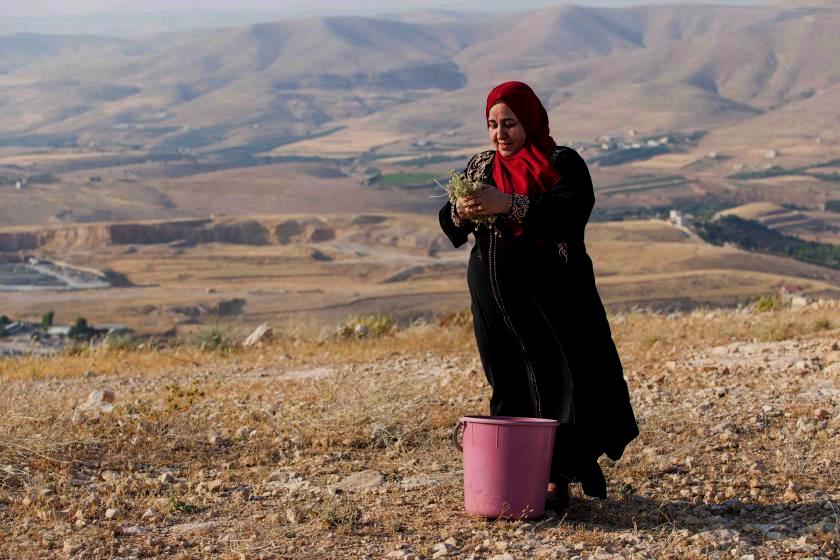Khatmah thought the hima was lost forever. Decades ago the water in this dry rangeland surrounding her village in north-west Jordan had started to disappear, and it had become little more than a wasteland.
“I thought it was pointless trying to regenerate the hima,” Khatmah says, pouring sweet black tea for her guests.
Taken from the Arabic for “a protected area”, a hima is a piece of common land managed by the community. Hima have been passed down through the generations in areas of the Middle East and North Africa for over 1,400 years. But in the second half of the 20th century, Jordan nationalized its rangelands and the hima system fell apart.
Overgrazing compounded problems of desertification and, as both water and pasture vanished, herding families like Khatmah’s were forced to sell their remaining livestock and find jobs elsewhere.
Returning to the land
Khatmah found work in a textile factory in the city. But after returning home to care for her ailing mother, she saw an opportunity to help restore the family’s traditional livelihood as a member of the village’s hima association, as part of a project aimed at reviving traditional institutions to achieve sustainable rangeland management.
Having gained rights over a 100-hectare (250 acres) plot of degraded state-held land, the association set rules outlining access to the hima that would allow the rangeland to regenerate. Meanwhile, practical training helped the villagers to develop systems to manage use of the hima—from access to grazing, seeding, harvesting and patrolling.
As a woman, Khatmah was used to being sidelined in community meetings, but she soon became a leading voice in decision-making around the hima and its management.
“Now they listen to me,” she smiles. “They accept my ideas and come to help when I say the hima needs to be protected against illegal grazing.”
Sustainable management, shared benefits

Controlled grazing has been an important part of allowing the hima around Bani Hashem to regenerate. Photo by UNEP / Lisa Murray
The association decided that pastoralists would only graze livestock in the autumn, while Khatmah and other women would harvest medicinal herbs from the rangeland in the spring.
After two years, the hima had started to regenerate and the increased availability of pasture enabled herders to save money by buying less fodder. Khatmah and other women in the community were taught how to process medicinal herbs into teabags, providing a much-needed income boost and proving the potential for generating new revenue streams from the land.
“After two years, the soil has become moist and regained life. Everything is bigger, better, fresher and smells better,” Khatmah says. “If the rangeland is healthy, it will be booming for the local people and we can really benefit. I want to see other villages doing the same.”
The success of the project has shown how traditional sustainable rangeland management systems can help communities understand threats to their land, and to work together to manage land use to tackle degradation and desertification head on—enabling damaged ecosystems to recover alongside local livelihoods.
Now, Khatmah dreams of seeing the hima system expanded across the rest of her local rangeland.
The Healthy Ecosystems for Rangeland Development project (HERD) is a four-year, Global Environment Facility-funded initiative bringing international experience and scientific expertise in ecosystem restoration to efforts to scale up proven approaches such as hima across half a million hectares in Jordan and Egypt.
Led by the UN Environment Programme (UNEP) in collaboration with the International Union for Conservation of Nature and national partners, HERD is supporting communities to create inclusive rangeland management plans, while developing institutional capacity to ensure that these plans are integrated into policy and backed by wider legislation.
HERD is just one of more than 80 projects the UN Environment Programme has implemented with the backing of the Global Environment Facility in support of the UN Convention to Combat Degradation and Desertification and other efforts to bring a halt to the threat of land degradation globally.
Featured photo (by UNEP / Lisa Murray) shows Khatmah exploring for tea made from local medicinal herbs, which will prove the potential for new revenue streams from the area’s restored rangelands.
This story was originally published in Voices from the land: Restoring soils and enriching lives. Download the book here.
This excerpt first appeared on the UNEP website. Reprinted by permission.

